Over the summer, I had the wonderful opportunity to go to Japan with my family for two and a half weeks. I had an amazing time in Japan seeing places such as Tokyo, Osaka, and Kyoto. In this article I will describe more about these cities and the country of Japan, delving into important landmarks, cultural traditions, and facts that make Japan a uniquely spectacular place to visit.
Japan as a Whole
First of all, a little bit about Japan. Japan is an island country in East Asia with roughly 124 million people and is divided into 47 different prefectures, ranging in size and population. Japan is a constitutional monarchy with a bicameral legislature, the only state in the world still ruled by an emperor. Japan has a GDP of about 6.721 trillion USD (that is a GDP per Capita of around 54,184 USD) making its economy one of the largest in the world. Japan is also part of many international organizations like the G7, United Nations, and APEC. Japanese is by far the most common language in the country and the Japanese writing system incorporates three different types of alphabets (Kanji and two types of Kana). Other languages and writing systems exist in the country, like Ryukyuan and Ainu, though they are not widely spoken and found only in the outermost parts of the state. The main religions in the country are Shintoism and Buddhism with many people in Japan participating in both of them. Japan also has many UNESCO World Heritage sites, many of which will be explained later in the article.
Tokyo
The first place me and my family got to go visit was the city of Tokyo. Tokyo is the most important city in Japan as it is the country’s capital and it is the largest city in the world with a greater metropolitan area including over 38 million people, greater than the population of Canada. Tokyo is divided into many districts like Ginza, Shibuya, Asakusa, Otemachi and Ueno with each district having its own unique landmarks and cultures. For example, the district of Ginza is known for having large department stores and being a very modern and glitzy neighborhood, while Otemachi has many skyscrapers and is mostly a business district.
Tokyo has many famous ancient landmarks rich in history and culture. One extremely famous site in the city is Senso-Ji Temple, the oldest Buddhist temple in all of Tokyo. The temple is dedicated to Guanyin, the Buddhist God of Mercy, and it regularly sees over 30 million visitors annually. Matching the temple in grandeur is the Meiji Jingu Shrine, a Shinto place of worship that covers a large part of central Tokyo. The Shinto shrine is dedicated to the late Emperor Meiji and his wife Empress Shoken. The shire is also a great place to escape from the noise and chaos of the city as it feels tranquil with all of its trees. Tokyo hosts the Imperial Palace, the residence of the emperor, empress, and their daughter. The palace is completely closed off to the public for most of the year, but one can still walk through the Imperial Palace gardens and see the Edo Castle ruins which lie on the property.
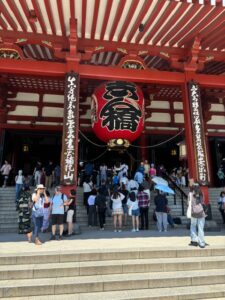
On the contrary, Tokyo also includes many modern landmarks that are just as iconic. An example would be Tokyo Tower, which is a massive communications and observation tower built in the 1950s standing at an impressive 332.9 meters with inspiration in its design from the Eiffel Tower. The tower offers amazing views of the city and many of its other landmarks. Another example would be the new Toyosu Shijou Fish Market, one of the largest fish markets in the world. At around 5:30 in the morning, bidding begins to obtain some of the most prized tuna in the world, some of which are shipped as far as Paris, New York, and Los Angeles. Tokyo also has the largest pedestrian crossing in the world in the Shibuya district, called Shibuya Crossing. Shibuya Crossing sees between 260,000 to 390,000 people cross every day, and on some of the busiest days as many as 500,000 people cross; that can be up to 1.5 million pedestrians a week. The crossing is flashy with lots of shops and large billboards surrounding it. Overall Tokyo is an amazing city and I would definitely recommend traveling there one day.
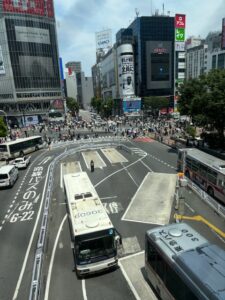
Kyoto
The next thing my family did was go to the very culturally important city of Kyoto. Kyoto was the old capital of Japan for 1,000 years until it was moved to Tokyo in the Edo Period. Kyoto is the largest city and capital of Kyoto Prefecture with a population of around 1,469,000 people as of 2020, making it the ninth most-populous city in Japan. Kyoto is mostly known for its ancient sights, although it is still a very modern city.
Some of the most famous sights in all of Japan are found in the city of Kyoto. This includes sights like the Golden Pavilion (Kinkaku-ji) which is a Zen Buddhist temple. The temple is known for its beautiful architecture with gold leaf covering the entire façade and its gorgeous grounds and gardens. The Golden Pavilion is a UNESCO World Heritage Site and to some, it is the most beautiful site in all of Japan.
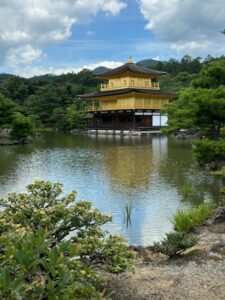
Another famous attraction is the Fushimi Inari Taisha Shrine known for its 10,000 Torii Gates forming a path around a mountain. Each gate is paid for by a patron and walking under one represents a transition from the mundane world to the world of the divine. Walking under each gate around the mountain would take about three hours. In Kyoto one can also go to the Kyoto Imperial Palace, the palace where the emperor used to rule from until the capital was moved to Tokyo. The grounds of this palace are open to the public, unlike the one in Tokyo, and one can book tours during several different times of the day. When in Kyoto, it is also fun to walk around the old, traditional streets and buy Japanese goods from the many shops. Overall Kyoto is a beautiful city with a rich history and was my favorite part of the entire trip.
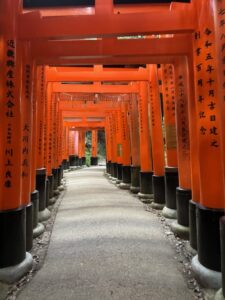
Osaka
After Kyoto, my family headed down to Osaka, a city quite near to Kyoto in the adjacent prefecture. Osaka is the capital and largest city in Osaka Prefecture with a population of around 2,754,000 people as of 2020, making it the third largest city in Japan after the cities of Tokyo and Yokohama. Osaka is known for its weirdness and unique cultural traits found nowhere else in Japan. An example of their uniqueness is the fact that in Osaka, it is considered polite to walk on the right side of stairs and wait on the right side of escalators. This is completely different from the rest of Japan which uses the left side. Also, in Osaka, the people there are known to eat a lot more food than in the rest of the country.
Osaka has many famous sites both modern and old. One of the most famous places in all of Osaka is the Dotombori neighborhood, known for its flashy lights and numerous street food stands. This neighborhood is always lively with elaborate advertisements and animatronic crabs enticing one to buy goods. Some of the famous foods that can be found here include fried octopus balls, Osaka cheesecake, sushi, crabs of all kinds, and Japanese savory pancakes. Another famous site would be Osaka Castle, an ancient feudal Japanese castle rebuilt many times due to war. The castle’s main keep is surrounded by two moats, and it is one of the largest in Japan, the main keep dominating the surrounding gardens.
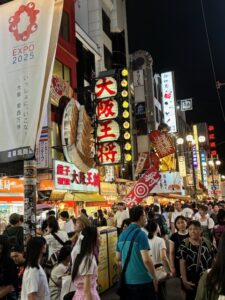
Conclusion
I enjoyed all of the sites that we visited in Japan, but my favorite would probably be the Golden Pavilion (Kinkaku-ji). The Golden Pavilion is spectacular to behold and is surrounded by an utterly beautiful landscape. I would highly recommend visiting Japan and getting to experience all of the wonderful things that make it such an amazing place.
Tune into The Roundup for more travel and country profiles!
